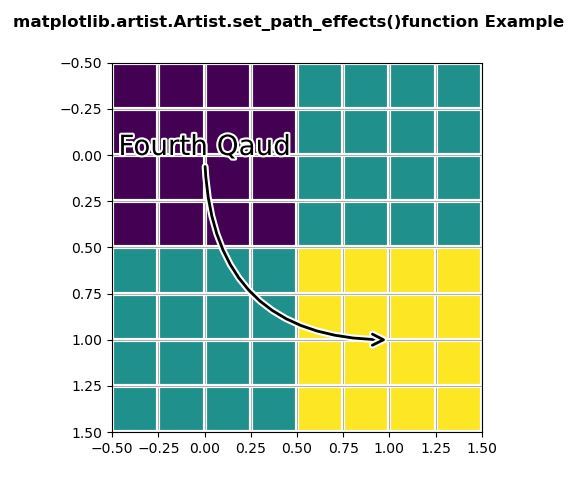Matplotlib es una biblioteca en Python y es una extensión matemática numérica para la biblioteca NumPy. La clase Artist contiene una clase base Abstract para objetos que se representan en un FigureCanvas. Todos los elementos visibles en una figura son subclases de Artista.
método matplotlib.artist.Artist.set_path_effects()
El método set_path_effects() en el módulo de artista de la biblioteca matplotlib se usa para establecer los efectos de la ruta.
Sintaxis: Artist.set_path_effects(self, path_effects)
Parámetros: este método acepta los siguientes parámetros.
- path_effects : Este parámetro es el AbstractPathEffect..
Devoluciones: este método no devuelve ningún valor.
Los siguientes ejemplos ilustran la función matplotlib.artist.Artist.set_path_effects() en matplotlib:
Ejemplo 1:
# Implementation of matplotlib function
from matplotlib.artist import Artist
import matplotlib.pyplot as plt
import numpy as np
import matplotlib.patheffects as path_effects
fig, ax = plt.subplots()
t = ax.text(0.02, 0.5,
'GeeksForGeeks',
fontsize = 40,
weight = 1000,
va ='center')
Artist.set_path_effects(t, [path_effects.PathPatchEffect(offset =(4, -4),
hatch ='xxxx',
facecolor ='lightgreen'),
path_effects.PathPatchEffect(edgecolor ='white',
linewidth = 1.1,
facecolor ='green')])
fig.suptitle('matplotlib.artist.Artist.set_path_effects()\
function Example', fontweight ="bold")
plt.show()
Producción:
Ejemplo 2:
# Implementation of matplotlib function
from matplotlib.artist import Artist
import matplotlib.pyplot as plt
import matplotlib.patheffects as PathEffects
import numpy as np
fig, ax1 = plt.subplots()
ax1.imshow([[1, 2], [2, 3]])
txt = ax1.annotate("Fourth Qaud",
(1., 1.),
(0., 0),
arrowprops = dict(arrowstyle ="->",
connectionstyle ="angle3",
lw = 2),
size = 20, ha ="center",
path_effects =[PathEffects.withStroke(linewidth = 3,
foreground ="w")])
Artist.set_path_effects(txt.arrow_patch, [
PathEffects.Stroke(linewidth = 5,
foreground ="w"),
PathEffects.Normal()])
ax1.grid(True, linestyle ="-")
pe = [PathEffects.withStroke(linewidth = 3,
foreground ="w")]
for l in ax1.get_xgridlines() + ax1.get_ygridlines():
Artist.set_path_effects(l, pe)
fig.suptitle('matplotlib.artist.Artist.set_path_effects()\
function Example', fontweight ="bold")
plt.show()
Producción:
Publicación traducida automáticamente
Artículo escrito por SHUBHAMSINGH10 y traducido por Barcelona Geeks. The original can be accessed here. Licence: CCBY-SA